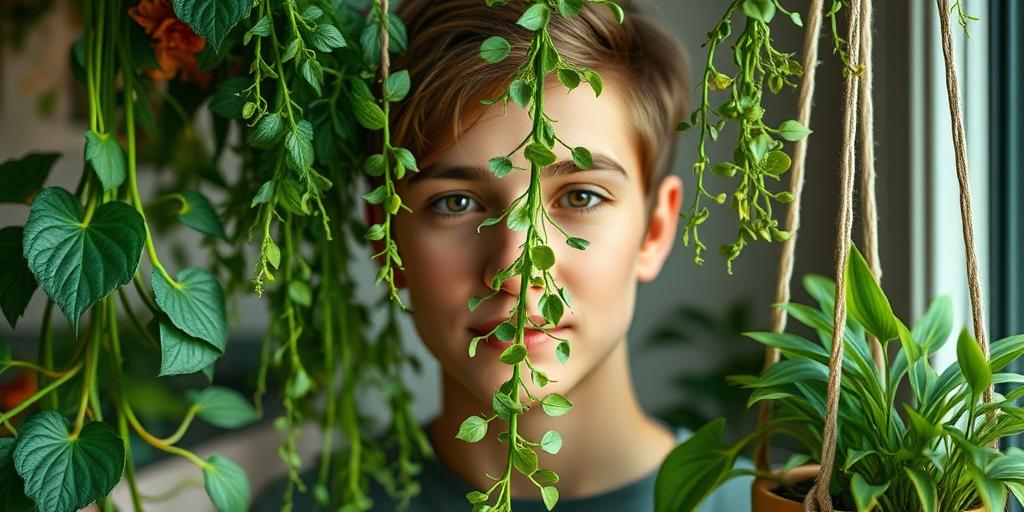
Low Light Hanging Plants: A Beginner’s Guide to Success
Discover the best low light hanging plants for beginners! Learn care tips, ideal varieties, and creative display ideas to bring life to dim spaces. Perfect for indoor gardeners!
Introduction
Do you dream of lush greenery but worry your home doesn’t get enough sunlight? Good news—low light hanging plants thrive in dim corners and bring vibrancy to any space! Whether you’re a busy plant parent or a beginner, these resilient beauties are perfect for adding a touch of nature without the fuss. Did you know some plants can survive with just fluorescent lighting? Let’s dive into the best low light hanging plants and how to keep them thriving!
Best Low Light Hanging Plants for Beginners
Pothos (Epipremnum aureum)
If you’re new to houseplants, pothos is your best friend. This nearly indestructible plant thrives in low light and can survive occasional neglect. Its long, cascading vines make it perfect for hanging baskets, where it can drape beautifully over the edges. Plus, it comes in several varieties, like golden pothos or marble queen, so you can pick one that matches your style.
Spider Plant (Chlorophytum comosum)
Spider plants are another excellent choice for beginners. Not only do they tolerate low light, but they also help purify the air. One of the coolest things about spider plants is how easily they propagate—just snip off one of the “babies” (spiderettes) and place it in water or soil to grow a whole new plant. Their arching leaves add a playful, textured look to any hanging display.
Philodendron Heartleaf
With its heart-shaped leaves and fast-growing vines, the heartleaf philodendron is a must-have for low-light spaces. It adapts well to different lighting conditions and doesn’t demand much attention. Let it trail from a hanging pot, and it’ll quickly fill out with lush greenery.
Peperomia
If you’re short on space, peperomia is a fantastic compact option. These small but mighty plants come in various textures and colors, from glossy green to ripple-edged leaves. They don’t need much light to thrive, making them ideal for dimmer corners.
String of Hearts (Ceropegia woodii)
For something a little more delicate, try the string of hearts. This trailing succulent has thin, heart-shaped leaves that dangle elegantly. While it prefers bright, indirect light, it can adapt to lower light conditions—just expect slower growth. Its unique appearance makes it a standout in any hanging arrangement.
How to Care for Low Light Hanging Plants
Watering
One of the biggest mistakes beginners make is overwatering. Most low-light hanging plants prefer their soil to dry out slightly between waterings. Stick your finger about an inch into the soil—if it feels dry, it’s time to water. If it’s still damp, wait a few more days. Overwatering can lead to root rot, so when in doubt, hold off.
Light Requirements
While these plants tolerate low light, they won’t thrive in complete darkness. Bright, indirect light is ideal, but they’ll manage in dimmer spots. If you notice your plant stretching toward the light (leggy growth), try moving it to a slightly brighter area—just avoid direct sun, which can scorch the leaves.
Humidity Needs
Most low-light hanging plants do fine in average indoor humidity. However, if your home is particularly dry (especially in winter), occasional misting or placing a small humidifier nearby can help. Peperomia and philodendrons especially appreciate a bit of extra moisture in the air.
Fertilizing
During the growing season (spring and summer), a diluted liquid fertilizer once a month will give your plants a little boost. Skip fertilizing in fall and winter when growth naturally slows. Over-fertilizing can harm your plants, so less is more.
Pruning & Maintenance
To keep your hanging plants looking full and healthy, trim back any leggy or yellowing growth. Regular pruning encourages bushier growth and prevents the plant from becoming too sparse. For vining plants like pothos or philodendron, you can even propagate the cuttings to grow new plants!
Creative Ways to Display Hanging Plants
Macramé Hangers
Macramé hangers add a boho-chic vibe to any room while keeping your plants at eye level. They’re perfect for small spaces since they don’t take up floor or shelf space. Mix and match different plant varieties in macramé hangers for a stylish, layered look.
Wall-mounted Shelves
If you love trailing plants but don’t want to hang them from the ceiling, wall-mounted shelves are a great alternative. Let plants like string of hearts or philodendron cascade down from the shelves for a living wall effect.
Ceiling Hooks
For a dramatic green canopy, install ceiling hooks and hang multiple plants at varying heights. This works especially well in corners or near windows where plants can get a bit more light. Just make sure your hooks are secure enough to hold the weight!
Tiered Plant Stands
Tiered stands let you showcase several plants at once without cluttering your space. Place a mix of low-light varieties at different levels to create visual interest. This is also a great way to group plants with similar care needs.
Glass Terrariums
If you have humidity-loving plants like ferns or peperomias, a glass terrarium can help maintain moisture while adding a modern touch. Hang them near a window for a stunning, glowing effect when sunlight filters through.
Common Problems & Solutions
Yellow Leaves
Yellow leaves are often a sign of overwatering. Check the soil—if it’s soggy, let it dry out before watering again. If the problem persists, consider repotting in fresh, well-draining soil.
Leggy Growth
If your plant is stretching out with long gaps between leaves, it’s likely not getting enough light. Move it to a brighter spot (but still indirect light) or prune back the leggy stems to encourage fuller growth.
Pests (Spider Mites, Mealybugs)
Pests can be a nuisance, but they’re manageable. Wipe leaves with a damp cloth and mild soapy water, or use neem oil as a natural treatment. Regularly inspect your plants to catch infestations early.
Slow Growth
If your plant seems stagnant, it might need more light or a gentle fertilizer boost. Adjust its placement and consider feeding it during the growing season.
Root Rot
This serious issue is caused by waterlogged soil. Always use pots with drainage holes, and avoid letting plants sit in standing water. If you suspect root rot, trim away affected roots and repot in fresh soil.
By choosing the right plants and following these care tips, you can enjoy lush, healthy hanging greenery—even in low-light spaces!
Conclusion
Low light hanging plants are the perfect solution for brightening up dim spaces with minimal effort. From the hardy Pothos to the elegant String of Hearts, there’s a plant for every style and skill level. With the right care and creative display, you can transform any corner into a green oasis. Ready to start? Pick your favorite plant and let nature do the rest!
